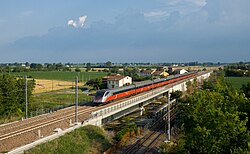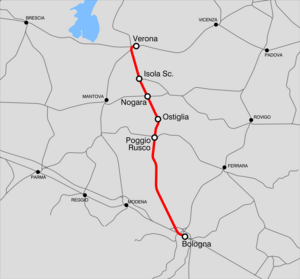Verona – Bologna railway line
| Verona – Bologna | |||||||||||||||||||||||||||||||||||||||||||||||||||||||||||||||||||||||||||||||||||||||||||||||||||||||||||||||||||||||||||||||||||||||||||||||||||||||||||||||||
|---|---|---|---|---|---|---|---|---|---|---|---|---|---|---|---|---|---|---|---|---|---|---|---|---|---|---|---|---|---|---|---|---|---|---|---|---|---|---|---|---|---|---|---|---|---|---|---|---|---|---|---|---|---|---|---|---|---|---|---|---|---|---|---|---|---|---|---|---|---|---|---|---|---|---|---|---|---|---|---|---|---|---|---|---|---|---|---|---|---|---|---|---|---|---|---|---|---|---|---|---|---|---|---|---|---|---|---|---|---|---|---|---|---|---|---|---|---|---|---|---|---|---|---|---|---|---|---|---|---|---|---|---|---|---|---|---|---|---|---|---|---|---|---|---|---|---|---|---|---|---|---|---|---|---|---|---|---|---|---|---|---|
|
The route at Revere
| |||||||||||||||||||||||||||||||||||||||||||||||||||||||||||||||||||||||||||||||||||||||||||||||||||||||||||||||||||||||||||||||||||||||||||||||||||||||||||||||||
| Route number (RFI) : | 43 (Verona – Poggio Rusco) 88 (Poggio Rusco – Bologna) |
||||||||||||||||||||||||||||||||||||||||||||||||||||||||||||||||||||||||||||||||||||||||||||||||||||||||||||||||||||||||||||||||||||||||||||||||||||||||||||||||
| Course book series (IT) : | 51 | ||||||||||||||||||||||||||||||||||||||||||||||||||||||||||||||||||||||||||||||||||||||||||||||||||||||||||||||||||||||||||||||||||||||||||||||||||||||||||||||||
| Gauge : | 1435 mm ( standard gauge ) | ||||||||||||||||||||||||||||||||||||||||||||||||||||||||||||||||||||||||||||||||||||||||||||||||||||||||||||||||||||||||||||||||||||||||||||||||||||||||||||||||
| Power system : | 3 kV = | ||||||||||||||||||||||||||||||||||||||||||||||||||||||||||||||||||||||||||||||||||||||||||||||||||||||||||||||||||||||||||||||||||||||||||||||||||||||||||||||||
| Top speed: | 200 km / h | ||||||||||||||||||||||||||||||||||||||||||||||||||||||||||||||||||||||||||||||||||||||||||||||||||||||||||||||||||||||||||||||||||||||||||||||||||||||||||||||||
|
|||||||||||||||||||||||||||||||||||||||||||||||||||||||||||||||||||||||||||||||||||||||||||||||||||||||||||||||||||||||||||||||||||||||||||||||||||||||||||||||||
The Verona – Bologna railway connects two important railway hubs in northern Italy with Bologna , the capital of the Italian region Emilia-Romagna , and Verona . The line is a central part of the Berlin – Palermo railway axis, but because of its single track it was also one of the most critical sections.
expansion
In order to meet the high requirements of a TEN axis, the line has been expanded in recent years. However, the expansion was not intended to create a pure high-speed line , but above all to increase the performance of the line so that a high-performance line is created.
The most important measures were:
- Increase in output from currently 90 to 210 trains per day in the future
- new top speed 200 km / h, for tilting technology trains 230 km / h
- Replacement of all level crossings by underpasses or overpasses
Until the end of 2007, the sections Bologna – S. Felice and Nogara – Verona in full operation. The next commissioning took place on October 26, 2008 (S. Felice – Poggio Rusco) and on December 14, 2008 (Poggio Rusco – Nogara; single-track on a section until January 2009). On June 26, 2009, the expansion work was completed with the commissioning of the second track in the Ostiglia - Poggio Rusco construction section .
The route is on the sections Bologna – S. Felice and Nogara – Verona are equipped with RSC cab signaling. An axle counting block is used in the middle section S. Felice – Nogara. The costly RSC was dispensed with in this last construction lot, as the line had meanwhile been planned as part of a TEN axis for future equipment with ETCS. Thanks to a new, simplified driver's cab signaling ( infill - anticipation of ETCS Level 1), this section of the route can also be driven at 200 km / h.
Points of criticism, especially on the middle section recently opened, are the extremely large block distances of up to 15 km and the small number of transfer and overtaking points. This is particularly noticeable due to the pronounced mixed operation with freight and local trains as well as express trains with 200 km / h.

